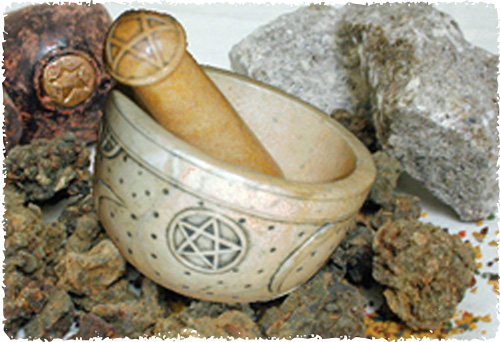How To Make Incense
- Details
- Written by AndEl

Incense in wicca, paganism, witchcraft, and the occult is extremely popular for good reason. The smoke from incense can infuse with your own energies while you are working rituals and spells enhancing the effects and potency. The scent from incense also can lure one into a deeper meditative state because depending on the ingredients used to make incense, they have the ability to deeply relax the mind and body allowing for a more pleasurable and intense meditative state.
There are basically three forms of incense - granular (or raw form), cones, and stick. The oldest form of incense is the natural granular incense and by far it's the easiest of the four to make. Loose incense usually burns on charcoal. Cone incense is economical to make and less messy than loose incense.
When learning how to make incense, the main thing to remember is that there are four basic ingredients that go into making incense, with the exception of the loose incense. They include your aromatic substance (which creates the scent), a base or chemical that helps the incense to continue to burn, some sort of bonding agent that holds it together and a liquid that allows the bonding agent to change into a type of glue.

When it comes to the aromatic substance, there are many scents to choose from.
Bark: woody, semisweet, mild
Berries: heavy, earthy, resin-like
Flowers: dry, grassy, semisweet
Gums: heavy, semisweet, resin-like
Leaves: dry, herby, grassy
Roots: earthy, heavy, woody, different
Seeds: bitter, smokey
Spices: sweet, dry, mild
Wood: woody, semisweet, mild
You can use any kind of herb you can possibly imagine to make incense. The same can be said to essential oils, which also can be used to make your incense. When using herbs, some give off stronger aromas then others, and depending on what you are using your incense for, you will have to experiment and discover how strong each scent will be once burned.
Things to consider when making incense
It's important to keep the proportion of aromatic substance at least twice as large as the base. Too much base can cause a strong after smell of smoke, so be careful not to overdo it.
When measuring ingredients in your incense recipe, be sure to use level teaspoons and always make sure your ingredients are grounded well, and as finely as possible. This will help ensure your final incense product burns clean and evenly.
When grounding down ingredients, use a mortar and pestle. A blender can be used for larger ingredients.
The key formula is: twenty parts aromatic substance, four parts base and one part bonding agent.
Bases
There are many types of bases to choose from. A base burns easily and gives off a nice odor when burning. The reason a base is needed for your incense is because most herbs burn poorly without one. The base helps make all bitter roots and herbs balance out and give them a smoother, milder fragrance. The most popular and easy to obtain bases are wood powder, sandalwood, red sandalwood, quassia, vetiver, willow, evergreen needles and talc. Wood powder is nothing more than sawdust that has been ground very fine. You can either buy it or make your own. Any lumber store will be more than happy to give you all the sawdust you can use.
Salt peter is added to incense to help reduce the burning time by 25 to 40 percent making your incense burn much longer. If you've ever bought and burned incense and notice that some burn forever while others burn out fast, salt peter is the reason. In case you don't know what salt peter is, it is a natural form potassium nitrate that they put in gunpowder and fireworks.
Choosing your bonding agent
The bonding agent is very important in good incense. You can choose from a variety of gums and resins including agar agar, ghatti gum, guar gum, gum arabic, brewer's yeast, locust bean gum, karaya, sodium alginate, tragacanth and xanthan gum.
Liquid
Any fluid can be used, but water is your best bet however you can use essential oils, wine, beer, and olive oil.
And finally...
Once you have the above ingredients, you can begin to combine them and can use them to form cones, cylinders or down hand rolled or dipped sticks. If all you want is the loose incense, then you are done.
You more than likely need something to crush up all these incense ingredients such as the herbs, and other materials that may not be already very fine and in powder form.
Mortar and Pestles are the best tool to use for this purpose.
For sticks you can use thin wood strips and dip it into your mixture. For cones you will need to shape them, the best thing to do for this would be to find a metal mold in the shape of a cone and then pour your incense mixture into it to form the cone shape.

Did you find this article helpful? For more insights on personal growth and wellness, explore CrystalWind.ca for spiritual guidance and wisdom, or visit AromaWorx.ca for natural ways to enhance your daily well-being. Share this article with others on their happiness journey:
Join the Conversation Now! Comment Below! ![]()
Latest Articles

Imagine a world of inspiration and healing, free for all—made possible by YOU!
Donate Now—Ignite the Magic at CrystalWind.ca!

Epilepsy - Finding A Cure
Your donation can make a difference!
Help us find a cure – donate now!
Unlock Your Light: Join Lightworkers Worldwide on CrystalWind.ca!
Articles: Wiccan Tools of the Craft
Follow Us!
Who is Online Now
We have 25768 guests and no members online
Featured This Month
The Crystal Wind Oracle Card Deck
The Crystal Wind Oracle™ The Crystal Wind Oracle Myth & Magic Card D... Read more
Green Aventurine
The Emotional Balancer Stone Green Aventurine is perhaps the best balancing... Read more
Bright Beltane Blessings!
The wheel turns to Beltane, also known as Mayday, marking the beginning of S... Read more
The Time of No Time: Beltane!
Around the medicine wheel of life we go, from season to season (solstice to ... Read more
Aries Mythology: Discover the Secrets
The Mythology of Aries When we dive into the mythology of Aries, we need to... Read more
Eudialyte: Your Aries Power Stone Revealed!
Eudialyte Birthstone: Aries Planet: Mars Element: Fire Chakra: Heart Eud... Read more
Budding Trees Moon: Medicine Wheel Insights!
Red Hawk - Fire Opal - Dandelion - Yellow March 21 – April 19 The Budding Tr... Read more
Dandelion: The Surprising Power of this Medi…
Reminds you of the abundance life holds. Gender: Masculine Planet: Jupiter E... Read more
Birth Totem Falcon: Are You a Natural Leader…
Birth Totem Falcon Birth dates: March 21 – April 19 Birth Totem is: Falcon... Read more
Sun in Aries: Unleash Your Power!
Aries March 21 through April 20 An Overview of Sun Sign Characteristics for A... Read more












































